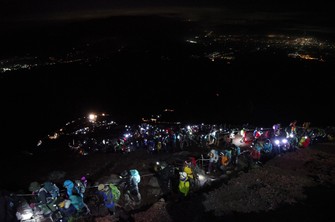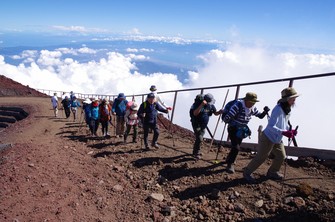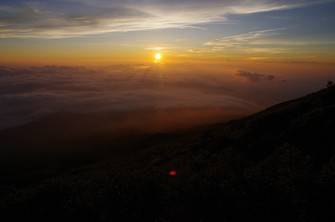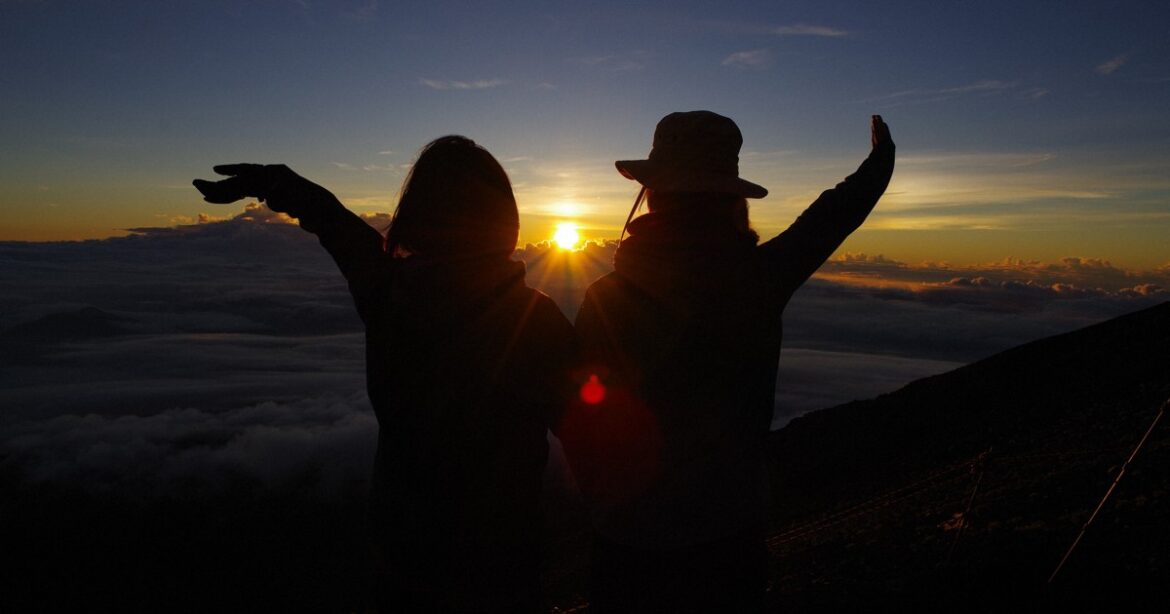TOKYO — Mount Fuji becomes crowded with hikers during the summer, with its trails known for their serious traffic jams. One factor contributing to this is when many hikers aim to view the sunrise from the summit, creating a large crowd ascending simultaneously.
Amid this situation, tours to intentionally watch the sunrise at the eighth station instead of the summit are gaining popularity. By shifting the schedule just a few hours, hikers can apparently enjoy a more comfortable climb.
Major trail congestion
The hike to observe the sunrise at the summit of Mount Fuji is not an easy one. Most tours aim to reach a mountain hut at the seventh or eighth station by the early evening, where hikers can rest. Afterward, they depart the hut around 11 p.m. to midnight. By about 4 a.m., they head for the summit to see the sunrise.

A congested trail of hikers, participating in a 2022 Mount Fuji climbing tour to see the sunrise from the summit, is seen. (Photo courtesy of Takayuki Wada)
Since so many hikers start climbing for the top at the same time, the trails become crowded. So-called “bullet climbing,” in which hikers attempt to reach the peak without sufficient rest, has been called into question.
Takayuki Wada, 34, from Bewave Inc., a travel agency based in Osaka’s Naniwa Ward, had never personally participated as a tour guide on a sunrise climb but had heard rumors about the difficulties such hikers faced, such as, “You have to walk the heavily congested trail to the summit without much sleep,” and, “The mountain huts are at high altitudes, and the unfamiliar environment makes it difficult to sleep.”
In 2021, Wada asked a guide at the Taishikan Hut at the eighth station for advice on tackling these issues. The guide told him, “You can see the sunrise from the eighth station, just like at the summit.”
The following year, he joined a summit climbing tour for the first time. The congestion was severe, and he had to stop frequently, unable to climb at his own pace. Some participants were physically exhausted due to a lack of sleep. He experienced the harsh conditions, just as the rumors had suggested.
Climbing to the summit at your own pace
Wada had an idea that avoiding the peak time might make the climb more comfortable. With that in mind, he worked on creating a tour incorporating the guide’s advice.

Hikers participating in a “relaxed Mount Fuji climbing tour” held by Bewave Inc. in 2023 head to the Kengamine peak. (Photo courtesy of Takayuki Wada)
The first such tour was held in August 2023. It was a two-night, three-day tour where participants watched the sunrise at the seventh and eighth stations on Mount Fuji.
On the first day, participants stayed at a mountain hut at the seventh station, and were given plenty of time to rest. On the second day, they watched the sunrise near the hut before heading to the highest point, the Kengamine peak.
On the third day, they stayed at the eighth station’s mountain hut and watched the sunrise again. All 14 participants made it to the summit, and they were also able to enjoy the sunrise while avoiding the congestion.
In response to the positive feedback, a one-night, two-day tour was conducted in 2024. The participants departed the eighth station’s mountain hut around 2 a.m., watched the breathtaking sunrise at a place referred to as the “original eighth station,” which is located closer to the summit, and then headed for the peak.
Wada, who experienced the effectiveness of “off-peak climbing,” noted, “You can avoid congestion by shifting the schedule by just a few hours, and you can climb to the summit at your own pace.”

A view of the sunrise from the seventh station mountain hut is seen during a “relaxed Mount Fuji climbing tour” held by Bewave Inc. in 2023. (Photo courtesy of Takayuki Wada)
This summer, tours will be held again in July and August. Bewave is planning to conduct four each of its one-night, two-day “original eighth station sunrise & Mount Fuji summit tour,” and its two-night, three-day “relaxed itinerary Mount Fuji climbing tour.”
Wada commented, “The original eighth station is at an altitude of 3,400 meters, higher than Mount Kitadake, which is Japan’s second-highest mountain (at 3,193 meters). Visitors can enjoy truly rare and beautiful views.”
Yamanashi Prefecture, on the north side of Mount Fuji, began charging a 2,000-yen (about $13)-per-person access fee last year to ease congestion and improve climbing safety. This year, the fee will increase to 4,000 yen (around $27). Shizuoka Prefecture on the south side will also follow suit, introducing a 4,000-yen entrance fee this summer.
Off-peak climbing, with hikers intentionally adjusting the time, seems likely to play a role in alleviating congestion.
(Japanese original by Maki Nakajima, Digital News Group)


AloJapan.com